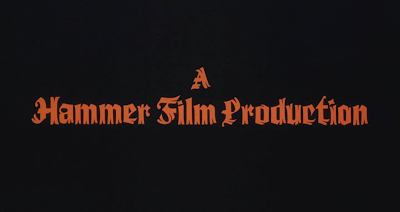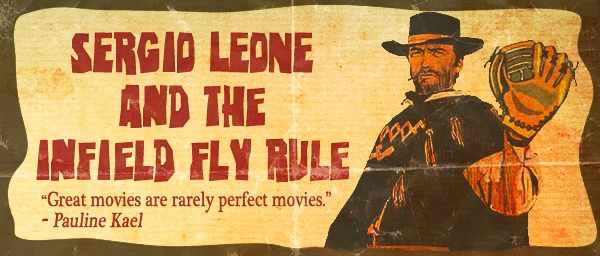
The cry
came forth from a dark corner of my living room as it usually does this time of
year, as it does sometimes during other parts of the year too. It was my wife,
shrieking from the depths of her soul, articulating a cry of despair and
disbelief: “You’re watching this again??!!” As the familiar strains of James
Bernard’s magnificent score rose from beneath the blood-red Warner Bros.-Seven
Arts insignia and the subsequent and equally scarlet opening credits, my wife
didn’t even need to look up from her book to realize what was happening. It was
the week before Halloween, and therefore time for my in-the-neighborhood-of-annual
dose of Terence Fisher’s masterful, terrifying Hammer classic, Frankenstein
Must Be Destroyed (1969), the
fifth in a line of gloriously lurid reiterations of the Frankenstein myth, the
pinnacle of the series for the studio, and a movie I’ve long considered to be
my favorite horror film and certainly one of my favorite movies, period.
Frankenstein Must Be Destroyed is a high point not only for Hammer, but also for the great
movie star and Hammer icon Peter Cushing, who wrings maximum effect from this
most acidic and horrifying interpretation of the good Dr. Frankenstein, all vestiges
of “good” having been leeched out of him in the years narratively separating FMBD from the previous installment, Frankenstein Created Woman (1967). And
it’s also a career peak, one of many, for the film’s director, the estimable
and often under-appreciated director Terence Fisher, whose tenure in the
Frankenstein series produced at least two, perhaps three inarguable classics,
of which Frankenstein Must Be Destroyed
is certainly the most brilliantly sustained, downright scary and, of all
things, the most unexpectedly moving.
This
year’s viewing came courtesy of a nifty Warners Blu-ray issued in 2015 which
shows the movie off in a spiffy and revelatory way, and I highly recommend it
to the movie’s legion of fans as well as to those who may as yet be unfamiliar
with the particular pleasures this movie serves up. In celebration of both the
Halloween season and Frankenstein Must Be
Destroyed, I offer this assessment of the achievements of Fisher, and
Cushing, of composer James Bernard, Freddie Jones, Simon Ward, Veronica
Carlson, screenwriters Bert Batt and Anthony Nelson Keys, and everyone else
involved in bringing this brutal extension of Mary Shelley’s legacy to the
screen. The following piece originally appeared on my blog, Sergio Leone and the Infield Fly Rule,
in 2007, and it is resurrected here, in much the same fashion as the
unfortunate doctor who becomes the subject of Baron Frankenstein’s hubristic
pursuit of pioneering brain transplant surgery, in a form only slightly altered...
************************

Director Terence Fisher began his 21-year run
at Hammer Films in 1952 with a film noir entitled The Last Page (aka Man Bait), but in 1957 he kicked off a fruitful 17-year stretch by
doing nothing less than fleshing out the template for the studio’s greatest
financial and artistic successes, which would send them all on an impressive
run of lurid yet stately horror films whose budgets were rarely betrayed by
their production values. Hammer began life in the mid-30’s, the inspiration of
two father-son pairs, James and Enrique Carreras and Will and Anthony Hinds.
These were filmmakers/businessmen who specialized in under-the-radar low-budget
fare which touched on all tones and subject matter, but they would find the
greatest success since the studio’s inception when they released 1955’s science
fiction thriller The Quatermass X-periment (known in the U.S. as The
Creeping Unknown). In the wake of a successful sequel, Quatermass II
(aka Enemy from Space), Hammer wisely decided to focus more or less
solely on horror and science fiction output, and thus the legendary eye of a
genre hurricane was truly born. The studio embarked upon what would ultimately
turn out to be a reinvention of the Universal horror film stable-- their first
four efforts, The Curse of Frankenstein (1957), Horror of Dracula
(1958), The Revenge of Frankenstein (1958) and The Mummy (1959)
were all directed by Fisher, and all four starred the venerable team of Peter
Cushing and Christopher Lee. And Fisher would turn out to be the director whose
style and career would become the most closely synonymous with Hammer horror.
By the
time he made Frankenstein Created Woman in 1967, Fisher had revisited
the well of the vampire twice (1960’s highly-regarded The Brides of Dracula,
with Cushing’s Van Helsing battling David Peel’s incarnation of the
blood-sucker, and 1966’s Dracula: Prince of Darkness which brought Lee’s
sophistication back to Bram Stoker’s vampire, this time sans Cushing), and the
director seemed ready to do something different with the Frankenstein formula.
He and screenwriter Anthony Hinds delivered a brilliant genre-twisting and
gender-bending idea: Frankenstein, still up to his usual existentially inspired
hijinks, has a body—that of a beautiful young woman—whose skull ends up housing
the brain of a wrongly executed man. But the brain is loath to cede its
identity, and soon the woman begins a campaign of vengeful murder visited upon
those who caused the young man’s fate. There’s some rather neat (for its time)
consideration of crossed-gender behavior thrown in the mix as well, and the
absence of an actual monster provided exactly the right downbeat note to keep
the level of inspiration in Hammer’s now four-film-old series running high.
(The
previous entry, The Evil of Frankenstein, was director Freddie Francis'
first contribution to the Hammer monster cycle-- he had previously directed Paranoiac
(1963) starring Oliver Reed and Nightmare (1964) for the studio. Evil
holds up well enough, but it was largely content to rehash the familiar motif
of the monster lumbering through the countryside, and as a result the movie is
considered to be a more minor entry in the series, though it marks perhaps
Cushing’s most benign interpretation of one of his two signature Hammer
characters.)




Fisher returned
for the fourth time to the continuing saga of Dr. Frankenstein in 1969. But
something about staging the battle of the sexes within a body at war with
itself seemed to have rather unhinged the good doctor. In previous episodes it
was fairly well understood that Cushing’s Frankenstein, as misguided as his
methods were, as blind as his God complex may have made him, had intentions
that were almost always good, regardless of how much death and destruction were
their result. But all that has changed by the time we first see Cushing in Frankenstein Must Be Destroyed
(1969). Here, Fisher and scenarists Bert Batt and
Anthony Nelson Keys waste absolutely no time putting whatever remains of
Frankenstein’s altruistic tendencies to their final rest. If it was to be
understood that Colin Clive’s obsessions to bring Karloff’s monster to life
were put into perspective by the monster’s inability to control the impulses
his damaged brain was sending to his stitched-together body, then Clive’s
characterization of Frankenstein, even into the narratives of the first two
sequels, at least retains some measure of sympathy due in large part to his own
empathy for his creation. This was true of Cushing’s Frankenstein too, despite
the more graphic stylization of the violence perpetuated by the monster,
reflected in the violence with which Cushing's Frankenstein had pieced together
his creation’s visage. But Frankenstein Must Be Destroyed opens with a
memorable sequence that makes audience identification with the titular surgeon
unlikely right from the start—Frankenstein, wearing a frightening rubber mask
that looks like a Captain Company version of Dustin Hoffman’s
old-man makeup in Little Big Man, stalks and decapitates a colleague
with a spray of the brightest Technicolor red, then threatens to do the same to
a wino who stumbles upon his storefront laboratory. Luckily, the wino ends up
only with the victim’s head in his lap—he gets to keep his own—and it’s not
long before Dr. Frankenstein must dump his current project and find other, more
shadowy digs.

Cushing
occupies Frankenstein here with an actor’s supreme confidence in his own
ability to hold an audience. He knows the direction the character is headed is
in one of irredeemable megalomania and condescension for those less intelligent
than he, but he never winks or otherwise elicits anything resembling a plea for
understanding. Instead, Cushing grabs the character by the throat and steers
the ride to hell through some truly harrowing territory. His icy stare and
vaguely regal air of superiority, mixed with a cunningly choreographed charm
that morphs out of his sharp, angular features whenever the need arises, have
rarely been put to better use than they were here. And few were better, in
either timing or timbre, with the kind of florid speeches, here laced with
seething anger and potential violence that were hallmarks of Hammer film
dialogue, than was Cushing.

Frankenstein
eventually checks in and lays low, under an assumed name, at a boarding house
run by Anna Spengler (Hammer siren Veronica Carlson), where he berates the other
residents for their dismissive attitude toward progressive science and his own
experiments, conducted in concert with another like-minded surgical maverick, a
Dr. George Brandt. He soon discovers that Anna’s boyfriend Karl (Simon Ward) is
a doctor at the mental asylum where Brandt, gone crazy before he could reveal
to Frankenstein the secret of successful brain transplantation, is being caged.
Karl is also involved in procuring illegal drugs for Anna’s ailing mother, and
Frankenstein uses that information to blackmail the couple into facilitating,
and taking part in, the continuation of his shrouded surgical experimentation.
It’s soon clear that Frankenstein’s motives go far beyond simple advances of
science for the benefit of mankind. This mad doctor truly is drunk on the idea
of pursuing success for his own name’s sake, but also in exercising that power
in rougher, more salacious and sinister ways. Already acknowledging that murder
is but a messy fly on his moral windshield, he also takes time out to assert
his dominance over Anna (and Karl) by humiliating her as often as possible and
finally, for no reason other than that he can, raping her. (This sequence, now
restored to the recent DVD and Blu-ray releases, was cut from the theatrical prints
released in the U.S.) And he eventually forces Karl to help kidnap the dying
Dr. Brandt from his cell and transplant Brandt’s brain into yet another body,
that of one of the asylum’s directors (Freddie Jones).

Frankenstein
Must be Destroyed was, of course, notable
for the increased level of violence of its tale, an appeasement to clamoring
Hammer fans made possible by the concurrent loosening of content standards both
in the U.K. and in the U.S. at the time. (The MPAA had only recently adopted
its rating system, which tagged FMBD with an “M”-- suggested for mature
audiences—and later re-rated it the perplexing yet somehow equivalent “GP,”
while it garnered an “18” certificate in Britain, limiting attendance to those
over 18 years of age, the equivalent of an “X” in America.) I was ten years old
when I saw FMBD in a theater, in
1970, and it marked the first time, I’m sure, that I’d ever seen a decapitation
(implied) on screen before, followed soon after by a generous display of the
bloody head. (Most horror fans my age probably witnessed their first full-on
separation of noggin from shoulders courtesy of The Omen in 1976.)
Upon
seeing the film again as an adult, what its violence seems most notable for now
is as another piece of evidence in the case for Terence Fisher as perhaps the
genre’s most efficient, underrated and under-regarded director. Fisher’s style
was lurid as the subject matter demanded—he took advantage of every rich color
splashed onto the sets by Hammer art director Bernard Robinson and knew exactly
how to maximize the erotic appeal of heaving bosoms traversed by a trickle of
blood. But his hand as a director had a measure of stateliness, which is
assuredly not a backhanded way of suggesting his camera was static or
unresponsive. He knew, as the well-trained and observant directors of his time
all knew, where to place the camera to emphasize the story and the effect that
the actor was going after. His films are quickly, expertly paced without being
over-edited or stuffed full of tricks meant to distract from the director’s
lack of confidence.

And
Fisher, given that somewhat classic style, was never one to condescend to his
material, even when, on occasion, it deserved derision. (Frankenstein and
the Monster from Hell, Hammer’s
last Frankenstein, was a lesser effort, an inauspicious way for
such an elegant director to end his career, but you’d never know it from the
way he visually signed the film.) Fisher was unafraid of seeming callous and
brutal due of the behavior of his characters. Yet he more often carried with on
the violation of a cranium by hand drill or surgical saw just under the frame,
without plunging the camera headlong into open cavities and gushing wounds,
thus freeing the imagination to do its worst while the camera kept its sturdy
gaze on the determination of the demented Frankenstein, or on the revulsion of
his reluctant assistants. He combined and balanced directorial economy and
lightning reflexes with the grand, velvety, bloody flourishes that were the
bread and butter of the Hammer film in a way that other directors at the studio
could occasionally approach but never truly match.
Frankenstein
Must Be Destroyed carries on with the
downbeat, nihilistic horrors that were amplified and expanded in Woman,
itself yet another instance, like its predecessor, of a Hammer Frankenstein
film absent the iconographic lumbering monster so often misidentified by its
creator’s name. Freddie Jones, not typically an actor associated with subtlety,
is allowed to paint a portrait of exceptional pain as “the creature,” whose
brain (that of Dr. Brandt) cannot process or accept the reflection of another man’s
body, shaved bald and sporting a ragged stitch to hold his skull cap tight, in
his mirror. And neither can Brandt’s wife, to whom he returns one night, unable
to reveal himself for fear of her inability to understand what he is telling
her about who he is. (He hides behind a changing partition as he speaks to her,
and his pessimistic presumption turns out to be agonizingly accurate.) Jones
draws us in deep, through his eyes welling with tears, into the tormented state
of this doctor, once Frankenstein’s colleague, now a victim of the same
arrogance he once perpetuated. This portrait, seething with confusion, rage and
newfound empathy for those in his own past whom he subjected to callous
experimentation in the name of a greater good, is among the finest in the
entirety of the Hammer Films catalogue, a catalogue already not unfamiliar with
good actors who choose to rise to the occasion instead of bend down to pat it
on the head. It is Brandt’s helpless anger, illuminated by Jones’ heartfelt and
committed portrayal, and Fisher’s sensitivity toward the character’s plight,
that finally lifts Frankenstein Must Be Destroyed, despite its rather
clipped finish, above the usual fare and into the realm of the finest
treatments and variations of the Frankenstein legend ever filmed.
*****************************




























































